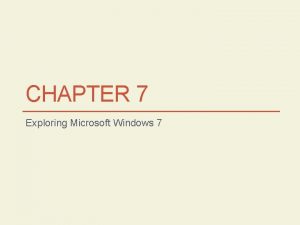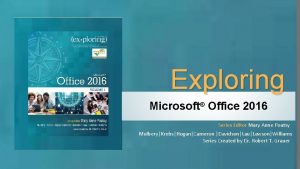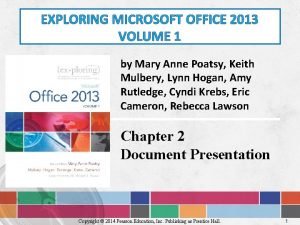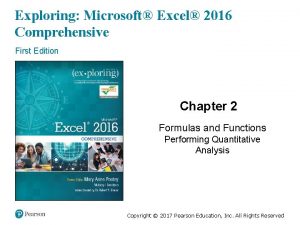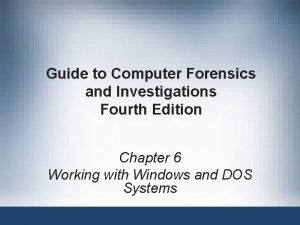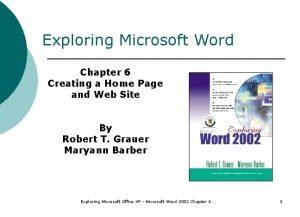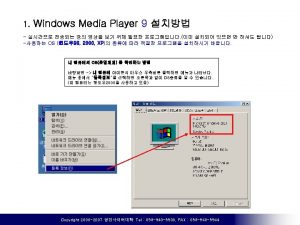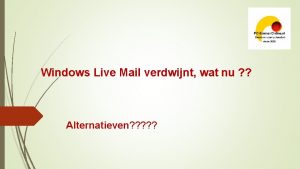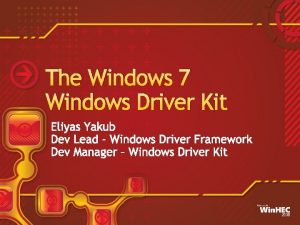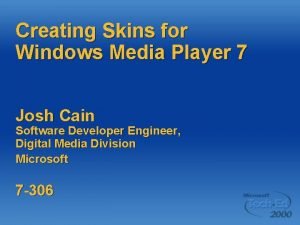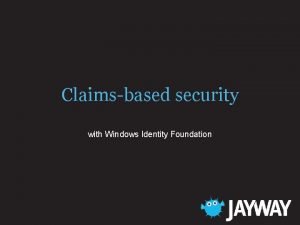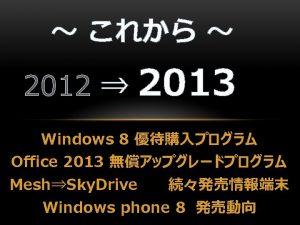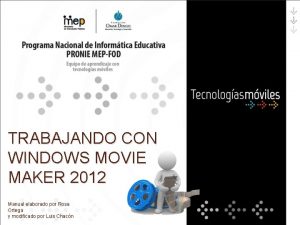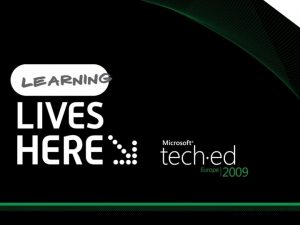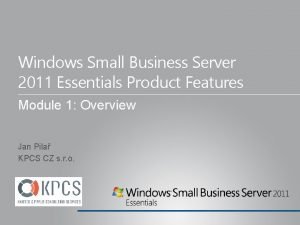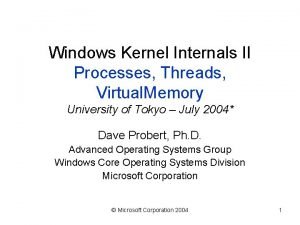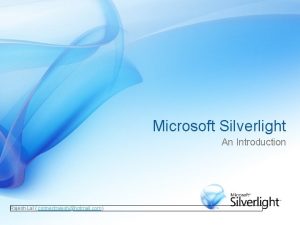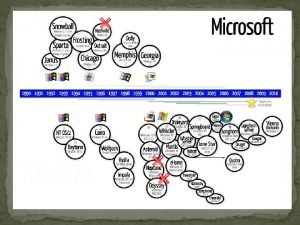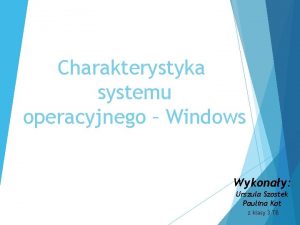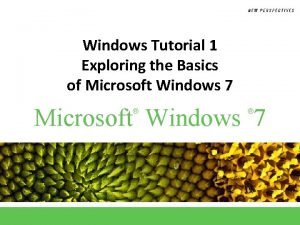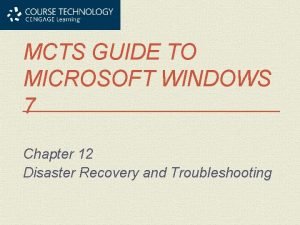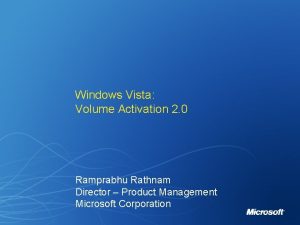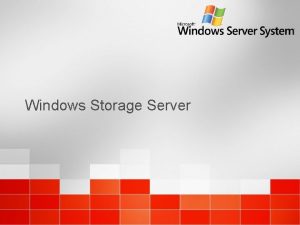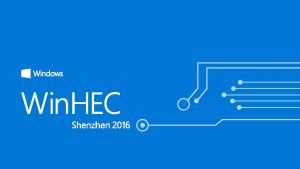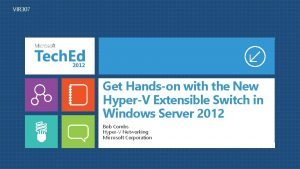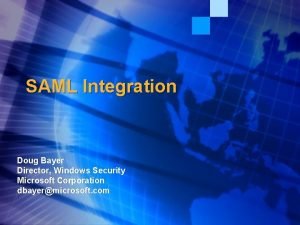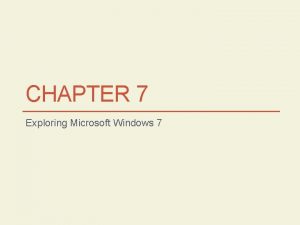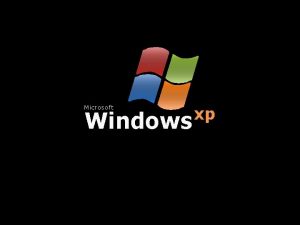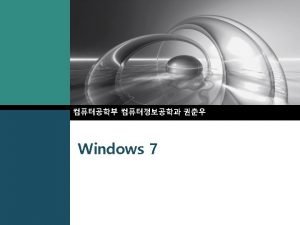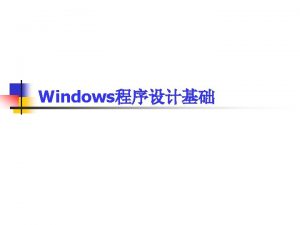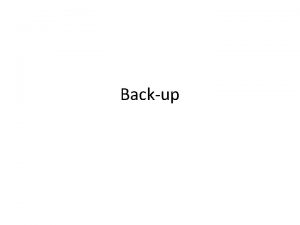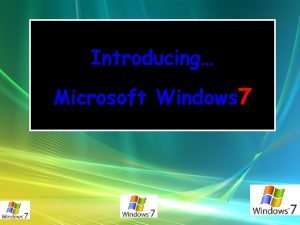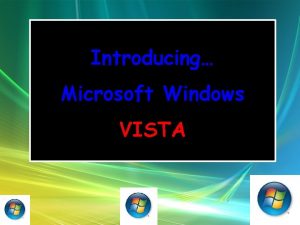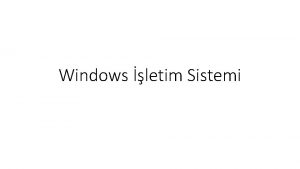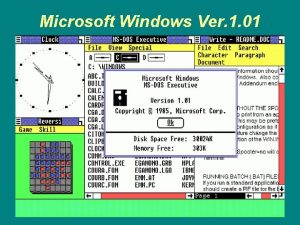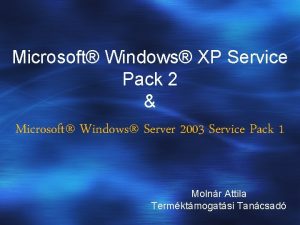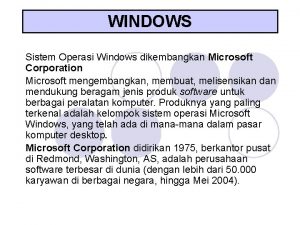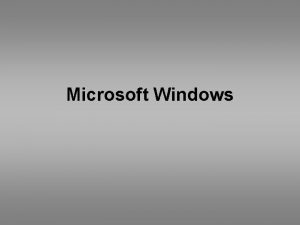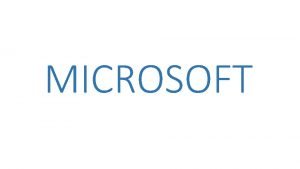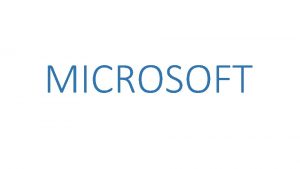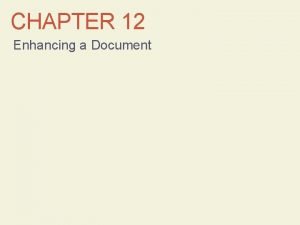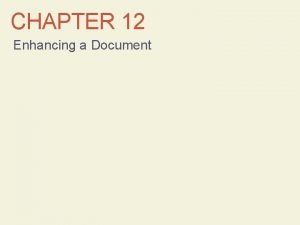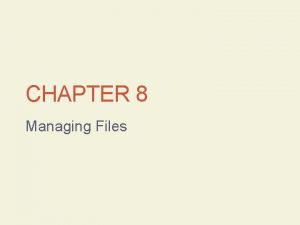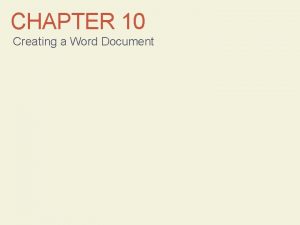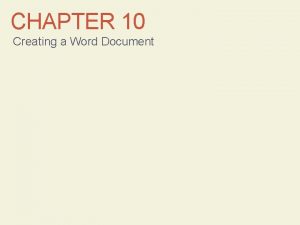CHAPTER 7 Exploring Microsoft Windows 7 CMPTR Chapter





































- Slides: 37

CHAPTER 7 Exploring Microsoft Windows 7

CMPTR Chapter 7: Exploring Microsoft Windows 7 Learning Objectives • Identify the parts of the Windows 7 desktop • Use common Windows elements • Navigate Windows • Work with the Recycle Bin • Get Help • Shut down Windows 2

CMPTR Chapter 7: Exploring Microsoft Windows 7 Exploring the Windows 7 Desktop • Topics Covered: • Starting Windows and Examining the Desktop • Using the Mouse • Exploring the Start Menu 3

CMPTR Chapter 7: Exploring Microsoft Windows 7 Starting Windows and Examining the Desktop • To start Windows, you simply turn your computer on. • One of three screens will appear • Desktop • User icons • Classic login 4

CMPTR Chapter 7: Exploring Microsoft Windows 7 Starting Windows and Examining the Desktop • The desktop is the whole workspace on the screen. • A desktop’s theme is a set of backgrounds, window colors, sounds, and screen savers. 5

CMPTR Chapter 7: Exploring Microsoft Windows 7 The Windows Desktop Icons - is a small picture or symbol serving as a quick, intuitive representation of a software tool, function or a data file accessible on the system. 6 Gadgets - mini programs that offer information at a glance and provide easy access to frequently used tools. Theme – a set of desktop backgrounds, window colors, sounds, and screen savers. Taskbar - horizontal bar at the area bottom of the Notification - part of the taskbar that screen that accessinformation about Button - graphical icon you with clickbuttons to start a provide displays icons quick that provide common tools and programs. program or perform atocommand. the running computer and programs that are running.

CMPTR Chapter 7: Exploring Microsoft Windows 7 Pointer • The pointer is a small object that moves on the screen when you move your mouse. • Common pointer shapes 7

Using the Mouse CMPTR Chapter 7: Exploring Microsoft Windows 7 8 • Point: Positioning the pointer directly on top of an item. • Click: Pressing the left mouse button and immediately releasing it. • Right-click: Clicking the right mouse button and immediately releasing it. • Double-click: Clicking the left mouse button twice in quick succession. • Drag: Positioning the pointeron top of an item, and then pressing and holding the left mouse button while moving the pointer.

CMPTR Chapter 7: Exploring Microsoft Windows 7 9 Screen Tip • When you want more information about an item on the desktop, you can point to that item to make a Screen. Tip appear.

CMPTR Chapter 7: Exploring Microsoft Windows 7 10 Aero Peak • You can use Aero Peek to quickly preview open windows without leaving your current window behind. • Point to a taskbar button to see a thumbnail preview of that window, • Point your mouse to that thumbnail to preview the window full- screen. • If you decide you want to switch to the window you’re previewing, just click the thumbnail. It’s unbelievably useful.

CMPTR Chapter 7: Exploring Microsoft Windows 7 11 Shortcut Menues • A shortcut menu lists actions you can take with the item you right-clicked. • You can right-click practically anything on the desktop, including a blank area of the desktop, to view commands associated with that item.

CMPTR Chapter 7: Exploring Microsoft Windows 7 12 Exploring the Start Menu • The Start menu provides access to programs, documents, and much more. • The Start menu is organized into two panes, or separate areas of a menu or window.

CMPTR Chapter 7: Exploring Microsoft Windows 7 Exploring the Start Menu Left Pane List of recently used programs. 13 Right Pane Icon associated with your account Your account name appears here Commands to access common locations on your computer Commands to access tools on your computer All Programs submenu Search Box Buttons for logging off and shutting down your computer

CMPTR Chapter 7: Exploring Microsoft Windows 7 All Programs Submenu Individual programs Program submenus 14

CMPTR Chapter 7: Exploring Microsoft Windows 7 Search Box 15

CMPTR Chapter 7: Exploring Microsoft Windows 7 Exploring the Start Menu • The bottom of the right pane allows you to open windows that help you effectively work with Windows 7. • Computer. • Control Panel • Devices and Printers • Help and Support 16

CMPTR Chapter 7: Exploring Microsoft Windows 7 Using Common Windows Elements • Two types of windows: • Program windows • Windows Explorer windows • Topics Covered: • Resizing and Moving Windows • Switching Between Open Windows 17

CMPTR Chapter 7: Exploring Microsoft Windows 7 Common Window Elements Title barbuttons -title a banner at the topprogram of a Sizing - Used tothe enlarge, Window - Identifies window displays the window title shrink, orthat close a window. and document contained in the window. and contains the sizing buttons. Details pane/Status bar Displays information or messages about the task you are performing or the selected item 18

CMPTR Chapter 7: Exploring Microsoft Windows 7 Resizing and Moving Windows 19 • After you open a window, you can manipulate it by changing its size and position. • In most windows, three sizing buttons appear on the right end of the title bar: • Minimize button • Maximize button • Restore Down button • Close button

CMPTR Chapter 7: Exploring Microsoft Windows 7 Switching Between Open Windows 20 • When more than one window is open on the desktop, there can only be one active window. • If you want to work on another window, you must switch between windows. • Taskbar • Aero Flip 3 D ( + tab) • Windows Flip (alt + tab)

CMPTR Chapter 7: Exploring Microsoft Windows 7 Navigating Windows 21 • Navigate means to move from one location to another on your computer, such as switching between windows

CMPTR Chapter 7: Exploring Microsoft Windows 7 Navigating Windows 22 • The Computer window represents your computer and its storage devices. • In Windows Explorer you are looking at the contents of the computer, a drive, or a folder.

CMPTR Chapter 7: Exploring Microsoft Windows 7 Windows Explorer 23 • Windows explorer displays; • Each storage device you can access on your computer usually associated with a letter. • Folder - containers that helps to organize files on a computer, just like a paper folder is used to organize files in a file cabinet. • A library is a central place to view and organize files and folders stored anywhere that the computer can access, such as those on your hard drive, removable drives, and network.

CMPTR Chapter 7: Exploring Microsoft Windows 7 Parts of Windows Explorer Window Address bar Search box Navigation pane Contents pane Details pane 24

CMPTR Chapter 7: Exploring Microsoft Windows 7 Navigating Windows • Topics Covered: • Using the Navigation Pane • Changing the View of Windows 25

CMPTR Chapter 7: Exploring Microsoft Windows 7 26 Using the Navigation Pane • The navigation pane as it names implies is used to navigate between drives, folders and libraries. • The navigation process will be demonstrated in the next slide.

CMPTR Chapter 7: Exploring Microsoft Windows 7 Using the Navigation Pane Currently looking Clicking onwe theare triangle in at whatofisacontained in the will front library or folder libraries Notice that open that folder and display thefolders triangle is pointing down the inside. (subfolders) Note that the libraries listed have open triangles in front Note that This the folders inside of of them. indicated there the folders do notinside have are 1979 additional triangles, this indicates that of the library. this folder only contains files. Clicking on a folder with no triangle will show the files that folder contains. 27

CMPTR Chapter 7: Exploring Microsoft Windows 7 Viewing Contents of Folders. When you click on a folder icon you see the contents of that folder. 28

CMPTR Chapter 7: Exploring Microsoft Windows 7 Viewing Contents of Folders. • Windows 7 provides a variety of ways to view the contents of a folder: to do this you click on the “Chang your view drop down arrow • You will see the following choices. • Extra Large Icons • Medium Icons • Small Icons • List • Details • Tiles • Content 29

CMPTR Chapter 7: Exploring Microsoft Windows 7 Working with the Recycle Bin • The Recycle Bin holds deleted from the hard drives on the computer. until you remove them permanently. • Make it a practice to regularly empty the Recycle Bin, since storing many files in the Recycle Bin can slow down your computer’s start up time. 30

Getting Help CMPTR Chapter 7: Exploring Microsoft Windows 7 • Topics Covered: • Using the Contents List • Using the Search Help Box 31

Getting Help CMPTR Chapter 7: Exploring Microsoft Windows 7 32 • Windows Help and Support provides access to Help files stored on your computer as well as Help information stored on the Microsoft Web site.

Getting Help CMPTR Chapter 7: Exploring Microsoft Windows 7 33 Search help box Back and Forward Buttons Tool bar Links to basic assistance information Button to switch between online and offline help Link to find more information on the Microsoft Web site.

CMPTR Chapter 7: Exploring Microsoft Windows 7 Using the Contents List • The Contents list logically organizes all of the topics in Windows Help and Support into topics and categories similar to a table of contents in a book. • To access the contents list click the Browse Help button. • When you click on this button a list of categories will appear. 34

CMPTR Chapter 7: Exploring Microsoft Windows 7 Using the Search Help Box • If you can’t find the topic you need by clicking a link or using the toolbar, or if you want to quickly find Help pages related to a particular topic, you can use the Search Help box. 35

CMPTR Chapter 7: Exploring Microsoft Windows 7 Using the Search Help Box • Enter a word or phrase about the topic you want to find information on, In this case “Printing a document. • Click on the Search help button. • A list of results will appear. • Clicking on any of the results will show the information. 36

CMPTR Chapter 7: Exploring Microsoft Windows 7 Shutting Down Windows 37 • You should always shut down Windows before you turn off your computer. • Switch users – bring up a screen with a list of users that can use the computer. • Log off - closes all programs and logs you off of Windows. • Lock – takes you back to the login screen • Sleep - a power-saving state that allows a computer to quickly resume full-power. Sleep puts your work and settings in memory • Hibernation puts your open documents and programs on your hard disk, and then turns off your computer
 Microsoft windows movie maker windows 7
Microsoft windows movie maker windows 7 What navigate means
What navigate means Exploring microsoft office 2016
Exploring microsoft office 2016 Exploring microsoft office 2013 volume 1
Exploring microsoft office 2013 volume 1 Exploring microsoft office 2013 volume 1
Exploring microsoft office 2013 volume 1 Exploring microsoft office excel 2016 comprehensive
Exploring microsoft office excel 2016 comprehensive Exploring microsoft file structure
Exploring microsoft file structure Exploring microsoft office xp
Exploring microsoft office xp Windows live movie maker interface
Windows live movie maker interface Windows media player 9
Windows media player 9 Windows live mail xp
Windows live mail xp Windows driver kit windows 7
Windows driver kit windows 7 Windows 7 skins
Windows 7 skins Windows identity foundation windows 10
Windows identity foundation windows 10 Upgrade windows 7 to windows 10
Upgrade windows 7 to windows 10 How to setup a windows xp virtual machine
How to setup a windows xp virtual machine Nokia lumia 920 windows 10
Nokia lumia 920 windows 10 Windows live movie maker 2012
Windows live movie maker 2012 Ipseq
Ipseq Jake oshins
Jake oshins Small business server 2010
Small business server 2010 Microsoft windows small business server 2011 essentials
Microsoft windows small business server 2011 essentials Microsoft-windows-kernel-process
Microsoft-windows-kernel-process Microsoft office teams rajesh
Microsoft office teams rajesh Empresa fabricante de windows
Empresa fabricante de windows Game mark
Game mark Windows 7 premiera
Windows 7 premiera Microsoft windows tutorial
Microsoft windows tutorial Microsoft windows armendicott
Microsoft windows armendicott Microsoft windows logos
Microsoft windows logos Value octagon
Value octagon Microsoft windows logos
Microsoft windows logos Windows microsoft.com
Windows microsoft.com Microsoft windows storage server 2003
Microsoft windows storage server 2003 Microsoft windows 10 security update
Microsoft windows 10 security update Microsoft windows filtering platform hyper-v
Microsoft windows filtering platform hyper-v Microsoft bayer
Microsoft bayer Windows microsoft.com
Windows microsoft.com

